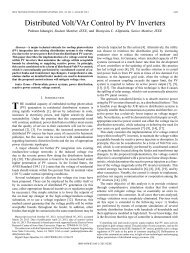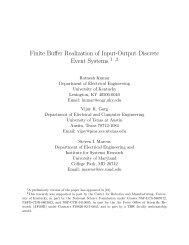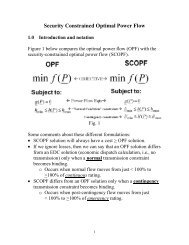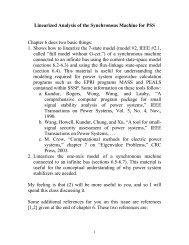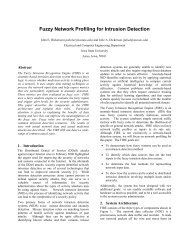EE 438/538 Optoelectronic Devices & Applications
EE 438/538 Optoelectronic Devices & Applications
EE 438/538 Optoelectronic Devices & Applications
You also want an ePaper? Increase the reach of your titles
YUMPU automatically turns print PDFs into web optimized ePapers that Google loves.
<strong>EE</strong> <strong>438</strong>/<strong>538</strong><strong>Optoelectronic</strong> <strong>Devices</strong> & <strong>Applications</strong>Part 1: Fundamentals of Optical Waves
Dipole Radiation• The starting point of most (if not all) optical problems• Dipole oscillation:– Two opposite electric charges oscillating– Oscillate along a common axis, crossing each othertwo chargesat restgettingacceleratedoverlappinggettingdeceleratedinstantaneous speedbecomes zerogettingacceleratedE fieldEzeroEH fieldzeroHimaxediH
Dipole Radiation Pattern & FeaturesAnimatedCross‐sectional1 Looping of E & H fields for each cycle: propagation!http://www.physics.upenn.edu/courses/gladney/phys151/lectures/lecture_apr_07_2003.shtml3D Bird’s eye2 Periodic changes in fieldpolarity and amplitude3 No radiation alongthe dipole axis
Dipole Radiation: The Importance• Electromagnetic (EM) waves generated by atoms excited by another EM wavecan be very accurately modeled with this dipole radiation model even thoughthe underlying physics are differentDipole Radiation: Too Ugly for Practical Use?I agree.But, just step back a littlefrom the source and youcan see that a large portionof the radiation patterncan be approximated by aspherical waver E rorE = r ⋅cos( ωt− k ⋅)
Spherical Wave & Plane Wave• The nicely shaped wave form of the spherical wave helps definingnew conceptsWave front‐ a.k.a. phase front‐ Surfaces with constant phaseWavevector k‐ magnitude: 2π /λ (propagation constant)‐ direction: normal to the phase front• Even farther away from the source? You will see a plane wave!Plane wave‐ flat phase front‐ k in parallelSpherical wave‐ spherical phase front‐ k in radial directionsrEr r= E ⋅cos( ωt− k ⋅)o
Obtaining EM Wave from Maxwell Equations• These waves can also be derived from Maxwell’s equations∇∇××rErHr∂ H= − μ∂ tr∂ E= ε∂ tsolving in Cartesiancoordinate system∇rE=2 1c2∂∂rE2t2solving in sphericalcoordinate systemrEr r= E ⋅cos( ω ⋅t− k ⋅)oPlane waveSpherical waver ErorE = r ⋅cos( ω ⋅t− k ⋅)There are two periods.T : temporal periodλ : spatial periodf (or ν) ≡ 1/T(temporal) frequencyω ≡ 2π fangular frequency
Plane Waves• The angular frequency and the propagation constant k are notindependent of each other• Consider the phase front we discussed graphically. It is defined as:ω⋅t – k⋅z = constant• Since the argument is a combined function of time and space, thephase front has to move in space at a certain velocityddtω −υ( ω ⋅t−kphase⋅≡dzdtck= ω −=⋅ z)≡ωkkddt⋅υconst.= 0phase=0Phase Velocity









